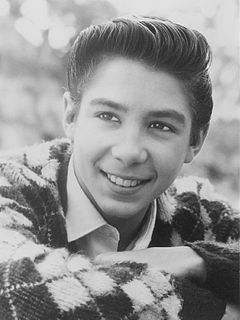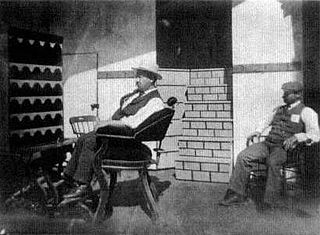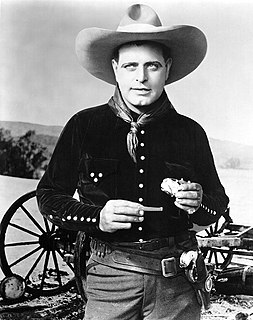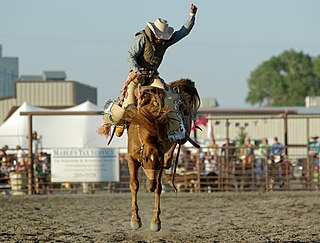Related Research Articles

The Western is a genre of fiction typically set in the 19th or early 20th century in the Western United States, commonly referred to as the "Old West" or the "Wild West" and depicted in Western media as a hostile, sparsely populated frontier in a state of near-total lawlessness patrolled by outlaws, sheriffs, and numerous other stock "gunslinger" characters. Western narratives commonly concern the gradual attempts to settle and civilize the untamed and crime-ridden American West, often in service of wider themes of justice, freedom, Manifest Destiny, and the national history and identity of the United States.
The following is an overview of the events of 1894 in film, including a list of films released and notable births.

Home on the Range is a 2004 American animated Western musical comedy film produced by Walt Disney Feature Animation and released by Walt Disney Pictures. The 45th Disney animated feature film, it was the last traditionally animated Disney film released until The Princess and the Frog in 2009 and Winnie the Pooh in 2011.

William Surrey Hart was an American silent film actor, screenwriter, director and producer. He is remembered as a foremost Western star of the silent era who "imbued all of his characters with honor and integrity." During the late 1910s and early 1920s, he was one of the most consistently popular movie stars, frequently ranking high among male actors in popularity contests held by movie fan magazines.

Gilbert M. "Broncho Billy" Anderson was an American actor, writer, film director, and film producer, who was the first star of the Western film genre. He was a founder and star for Essanay studios. In 1958, he received a special Academy Award for being a pioneer of the film industry.

Arthemus Ward "Art" Acord was an American silent film actor and rodeo champion. After his film career ended in 1929, Acord worked in rodeo road shows and as a miner in Mexico.

The Hall of Great Western Performers is a Hall of Fame at the National Cowboy & Western Heritage Museum. It is located in Oklahoma City, Oklahoma and sometimes referred to as the "Western Performers Hall of Fame". It is a 4,000-square-foot (370 m2) presentation that explores the various ways the west has been interpreted in literature and film. Every year the Museum inducts performers into the Hall of Fame at the same time the Western Heritage Awards are given out.

The actuality film is a non-fiction film genre that, like the documentary film, uses footage of real events, places, and things. Unlike the documentaries, actuality films are not structured into a larger argument, picture of the phenomenon or coherent whole. In practice, actuality films preceded the emergence of the documentary. During the era of early cinema, actualities—usually lasting no more than a minute or two and usually assembled together into a program by an exhibitor—were just as popular and prominent as their fictional counterparts. The line between "fact" and "fiction" was not as sharply drawn in early cinema as it would become after the documentary came to serve as the predominant non-fiction filmmaking form. An actuality film is not like a newspaper article so much as it is like the still photograph that is published along with the article, with the major difference being that it moves. Apart from the traveling actuality genre, actuality is one film genre that remains strongly related to still photography.

John Ernest Crawford was an American actor, singer, and musician. He first performed before a national audience as a Mouseketeer. At age 12, Crawford rose to prominence playing Mark McCain in the series The Rifleman, for which he was nominated for a Best Supporting Actor Emmy Award at age 13.

William Heise (1847–1910) was a German-born American film cinematographer and director, active in the 1890s and credited for more than 175 short silent films. Heise filmed a "We All Smoke" skit promoting Admiral Cigarettes in 1897.

3 Godfathers is a 1948 American Western film directed by John Ford and filmed primarily in Death Valley, California. The screenplay, written by Frank S. Nugent and Laurence Stallings, is based on the 1913 novelette The Three Godfathers by Peter B. Kyne. The story is something of a retelling of the story of the Three Wise Men in an American Western context.

The Resurrection of Broncho Billy is a 1970 live action short Western film directed by James R. Rokos and starring Johnny Crawford. It won an Oscar for Best Short Subject.

John Hartford Hoxie was an American rodeo performer and motion picture actor whose career was most prominent in the silent film era of the 1910s through the 1930s. Hoxie is best recalled for his roles in Westerns and rarely strayed from the genre.

Charles Pacific Morrison (1878–1924), an American silent film actor, was born April 3, 1878 in Morrison, Colorado. The grandson of pioneer town founder George Morrison, he was known as "Chick" to many who knew him, a nickname conjunction of his first and middle names. A keen horse rider, he often appeared in riding contests and rodeos throughout the American west. At Morrison he trained horses for trick and fancy riding as well as break in wild horses. In 1909 Essanay Studios brought one such horse to Morrison to film some of their famous Broncho Billy series of 2-reel thrillers. Morrison got the director's attention through his expert horsemanship, daring maneuvers, as well as his control over the animals, and was used as a double for the lead actor in some of the more dangerous scenes.

Wild West shows were traveling vaudeville performances in the United States and Europe that existed around 1870–1920. The shows began as theatrical stage productions and evolved into open-air shows that depicted romanticized stereotypes of cowboys, Plains Indians, army scouts, outlaws, and wild animals that existed in the American West. While some of the storylines and characters were based on historical events, others were fictional or sensationalized.
Buck Connors was an American actor. He appeared in more than 80 films between 1912 and 1941. He is the son of William L Conner and Leah Bowen. He was born in Streator, La Salle County, Illinois, and died in Quartzsite, Arizona., and is buried in Hi Jolly Cemetery in Quartzsite.
Broncho is a less common spelling of bronco, a horse with a propensity to buck.

A bucking horse is any breed or either gender of horse with a propensity to buck. They have been, and still are, referred to by various names, including bronco, broncho, and roughstock.

The Broncho Buster is a 1927 American silent Western film directed by Ernst Laemmle and starring Fred Humes, Gloria Grey and Buck Connors.
References
- 1 2 "Bucking broncho". Library of Congress. 1894. Retrieved July 1, 2021.